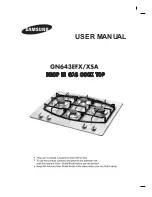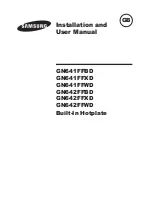
English 25
Oper
ation
Operating noises
You may hear the following operational noises:
•
Cracking noises
: You may hear a cracking noise when you are using cookware
made of two or more materials.
•
Whistling
: A whistling noise occurs when both back burners are in use.
This is caused by vibrations. Whistling can vary depending on the weight or
material of the cookware or the type of food you are cooking. (The noise can
be reduced by using thicker cookware.)
•
Humming
: You may hear a low humming when you set an element to a high
power setting. This sound is generated by energy transmission, and it will
disappear when cooktop is turned off.
•
Clicking
: Electric switches are operating.
•
Hissing, Buzzing
: You may hear a fan noise during cooktop operation. You
may continue to hear it even after the cooktop is turned off.
This is normal. The fan runs to cool down the temperature inside the cooktop.
It will automatically shut itself off after a short period of time.
These noises are normal and do not indicate any defects.
Using suitable induction cookware
Suitability test
Cookware is suitable for induction cooking
if a magnet sticks to the bottom of the
cookware and the cookware is labelled as
suitable by the cookware manufacturer.
Better pans produce better results
•
You can recognize good pots and pans by their bases. The base should be as
thick and flat as possible.
•
When buying new pots or pans, pay particular attention to the diameter of the
base. Manufacturers often give only the diameter of the upper rim.
•
Do not use pans which have damaged bases with rough edges or burrs. You
can scratch the ceramic cooktop permanently if you slide a pot or pan with a
damaged base across the surface.
•
When cold, pan bases are normally bowed slightly inwards (concave). They
should never be bowed outwards (convex).
•
If you want to use a special type of pot or pan, for example, a pressure cooker,
a simmering pan, or a wok, please follow the manufacturer’s instructions.
















































